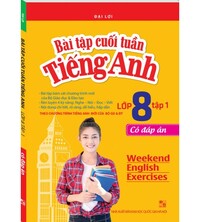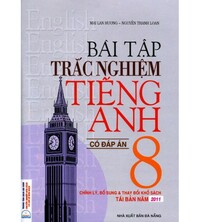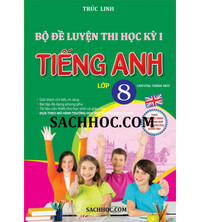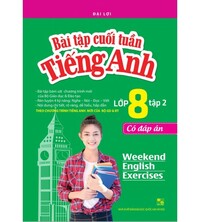Đề số 9 - Đề kiểm tra học kì 1 - Tiếng Anh 8 mới
Đề bài và hướng dẫn giải đề thi học kỳ I tiếng Anh 8 chương trình mới - Đề số 9.
Đề bài
A - LISTENING
I. Listen to the folk tale. Decide if the following statements are true (T) or false (F).
Question 1. The old man couldn’t see anything at all. ___________
Question 2. While eating at the table, he suddenly broke his bowl. ___________
Question 3. He has to sit in front of the stove to finish his meal. ___________
Question 4. The man’s grandson was under five years old. ___________
Question 5. The grandson took the man back to the table. ___________
II. Listen to a short speech about Shopping and fill in the numbered blanks with NO MORE THAN THREE WORDS.
Shopping must be one of the world’s most popular hobbies. I hate it. There’s nothing (6) than wandering around shopping malls. What a waste of time. I know a lot of people who like window shopping – just (7) shops without wanting to buy anything. Crazy! My plan for shopping is ‘quickly in, quickly out’. If I have to go shopping, I go in the morning on a (8) . This is when the stores are empty and you can get what you want quickly, without thousands of other shoppers getting in your way. The worst time to go shopping is on a (9) during sale season. It seems as though all of the world’s bargain hunters are in the same store as you. I was happy when (10) came along. This is very relaxing.
B - PRONUNCIATION
I. Find the word which has a different sound in the underlined part.
Question 11. A. wicked B. confused C. beloved D. naked
Question 12. A. companion B. comparison C. company D. compartment
II. Choose the word which is stressed differently from the rest.
Question 13. A. mountainous B. product C. literature D. unforgettable
Question 14. A. southern B. highland C. clothing D. experience
C - GRAMMAR
I. Choose the best answer (A, B, C, or D).
Question 15. ___________ the tortoise was slow, he was very steady and he could win the race.
A. Because B. When C. Although D. Despite
Question 16. In most fairy tales, good characters often ___________ a happy life after a lot of challenges.
A. make B. go C. do D. lead
Question 17. The hunter saved her life, so she wanted to do something for him in ___________.
A. again B. back C. return D. turn
Question 18. It is easy for the little girl to fall ___________ sleep when her mother tells her the favorite fairy tale.
A. in B. into C. to D. over
Question 19. Folk tales are very good for kids’ personality development because they ___________ kids with many moral lessons.
A. give B. help C. provide D. tell
Question 20. I prefer reading stories with happy endings ___________ ones with unhappy endings.
A. than B. to C. from D. rather
Question 21. I was glad when the ___________ step – mother had to live a miserable life until death.
A. merciful B. gentle C. cunning D. helpless
Question 22. I remember that I first ___________ that story when I ___________ 6 years old.
A. reads – am B. read – was C. readed – was D. read – were
Question 23. When our elder brother ___________ us a frightening story, suddenly there ___________ a big knock on the door.
A. was telling – was B. were telling – was C. told – was D. tells – is
Question 24. The Giong festival is held to ___________ Saint Giong who defeated the invaders.
A. remember B. commemorate C. miss D. remind
Question 25. The lion and dragon dances performed at the opening ceremony of the festival was very ___________.
A. impressed B. impress C. impressive D. impressing
D - READING
I. Read the passage. And decide if the statements are true (T) or false (F).
The dragon dance and the lion dance was originated from China, and it has been introduced to many parts of the world. The dragon dance and lion dance are also popular in some traditional festivals in Vietnam. Dragons symbolize wisdom, power and wealth, and they are believed to bring good luck to people. The origin of the dragon dance can be dated back to the Han Dunasty (206 BC – 220 AD). It was then used in a ceremony for worshiping ancestors and praying for rain, and it gradually developed into an entertainment activity. By the Tang Dynasty (618-907) and the Song Dynasty (960-1279), it had become a common ceremonial activity in festival like Chinese New Year.
The dragon body is woven in a round shape of thin bamboo strips, segment-by-segment, and covered with a huge red cloth with dragon scales decorating it. The whole dragon is usually up to 30 meters in length – and people hold rods every 1 to 2 meters to raise the dragon segments.
Question 26. The dragon dance came from China. ___________
Question 27. People think that the dragon dance is associated with luck. ___________
Question 28. The dragon dance was firstly performed for entertainment. ___________
Question 29. People performed the dragon dance to pray for less rain. ___________
Question 30. The whole dragon is usually much more than 30 meters in high. ___________
II. Read the text and choose the correct answer A, B, C or D for each of the gaps.
Native American Indian groups in North America lived (31) ___________ different cultural regions, each of which developed its own customs and traditions. A custom is the specific way in which (32) ___________ group of people does something. This can include how foods are prepared, what clothing is worn, the kinds of celebrations and much more. The set of customs developed and (33) ___________ by a culture over time is a tradition.
A culture’s customs are often determined by the natural resources found in their environment. In the Desert Southwest region, cloth weaving develop (34) ___________ a custom. The area has fewer large animals whose skins can be used for making clothing or blankets. Cloth weaving was a way (35) ___________ meeting the need for clothing without using animal skins. In the Eastern Woodlands area, however, hunting and fishing were daily activities. Since it was easy to get animal skins, developing skills like weaving were less important.
Question 31. A. in B. a C. on D. of
Question 32. A. the B. an C. a D. all
Question 33. A. to share B. sharing C. share D. shared
Question 34. A. as B. for C. by D. in
Question 35. A. by B. of C. to D. as
E - WRITING
Rearrange the following words to make a meaningful sentence.
Question 36. people / Kinh / in / together / lived / a harmony / the village / under.
=> _______________________________________________________ .
Question 37. villages / the / are / by / surrounded / bamboo groves.
=> _______________________________________________________ .
Question 38. considered / the husband / is / the family / of / the head.
=> _______________________________________________________ .
Question 39. to / went / live / the bride / with / husband’s / her / family.
=> _______________________________________________________ .
Question 40. my / grandfather / water pipes / smoking / enjoys / drinking / tea / and.
=> _______________________________________________________ .
----------THE END-----------
Lời giải chi tiết
Question 1. F
Question 2. F
Question 3. F
Question 4. T
Question 5. F
Question 6. more boring
Question 7. walking around
Question 8. weekday
Question 9. Saturday afternoon
Question 10. online shopping
Question 11. B
Question 12. C
Question 13. D
Question 14. D
Question 15. C
Question 16. A
Question 17. C
Question 18. B
Question 19. C
Question 20. B
Question 21. C
Question 22. B
Question 23. A
Question 24. B
Question 25. C
Question 26. T
Question 27. T
Question 28. F
Question 29. F
Question 30. F
Question 31. A
Question 32. C
Question 33. D
Question 34. A
Question 35. B
Question 36. Kinh people lived together in a harmony under the village.
Question 37. The villages are surrounded by bamboo groves.
Question 38. The husband is considered the head of the family.
Question 39. The bride went to live with her husband’s family.
Question 40. My grandfather enjoys smoking water pipes and drinking tea.
Search google: "từ khóa + timdapan.com" Ví dụ: "Đề số 9 - Đề kiểm tra học kì 1 - Tiếng Anh 8 mới timdapan.com"







